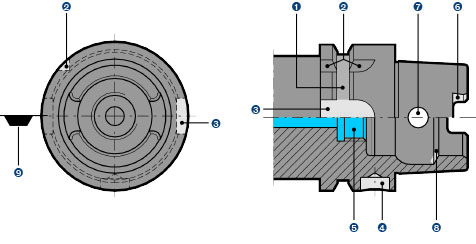The hollow taper shank (HSK) has prevailed since its standardization as an interface between machine and tool.
HSK benefits to the user include:
- High static and dynamic rigidity
- High precision axial and radial reproducibility
- High tool change accuracy and repeatability
- High speed machining performance
- Short tool changing times
- Coding and identification
- Coolant feed
Balancing recommendations and r.p.m. limits
Kemmler HSK-toolholders are generally pre-balanced to G 6.3/15,000 rev./min.
Fine balancing on request is possible.
Because the rotational speed is the largest influencing factor together with the limits regarding the spindle or spindle bearing interface, the following r.p.m. limits for HSK interfaces have been recommended as guidelines within the HSK standards:
HSK-A/C 32 to 30,000 rev./min
HSK-A/C 40 to 30,000 rev./min
HSK-A/C 50 to 30,000 rev./min
HSK-A/C 63 to 25,000 rev./min
HSK-A/C 80 to 20,000 rev./min
HSK-A/C 100 to 16,000 rev./min
Depending on the tool, it may be necessary to balance both the tool holder and tool when applying the maximum r.p.m. Exact limits can only be determined if machine and spindle manufacturers are taken into consideration and it is possible to define tools and projecting lengths.
Term definitions of HSK-A interface for automatic tooling systems

- Gripper groove: circular groove
- Index notch: sickle-shaped notch across gripper groove
- Keyway on collar: index notch or for attachment in tool magazine or grippers.
With HSK-B/D also provides form closed torque transmission to spindle. - Coding/identification: bore in collar for attachment of identification system (coding chip)
- Thread for coolant: for attachment of coolant supply set
- Keyway on taper shank: form closed torque transmission to spindle
- Radial bore in taper shank: necessary for manual clamping systems
- Clamping shoulder: circular chamfer for drawing in the tool
- Position of the tool edge of single-edged tools
The hollow taper shank (HSK) has prevailed since its standardization as an interface between machine and tool. HSK benefits to the user include: - High static and dynamic rigidity - High...
read more »
Close window
The hollow taper shank (HSK) has prevailed since its standardization as an interface between machine and tool.
HSK benefits to the user include:
- High static and dynamic rigidity
- High precision axial and radial reproducibility
- High tool change accuracy and repeatability
- High speed machining performance
- Short tool changing times
- Coding and identification
- Coolant feed
Balancing recommendations and r.p.m. limits
Kemmler HSK-toolholders are generally pre-balanced to G 6.3/15,000 rev./min.
Fine balancing on request is possible.
Because the rotational speed is the largest influencing factor together with the limits regarding the spindle or spindle bearing interface, the following r.p.m. limits for HSK interfaces have been recommended as guidelines within the HSK standards:
HSK-A/C 32 to 30,000 rev./min
HSK-A/C 40 to 30,000 rev./min
HSK-A/C 50 to 30,000 rev./min
HSK-A/C 63 to 25,000 rev./min
HSK-A/C 80 to 20,000 rev./min
HSK-A/C 100 to 16,000 rev./min
Depending on the tool, it may be necessary to balance both the tool holder and tool when applying the maximum r.p.m. Exact limits can only be determined if machine and spindle manufacturers are taken into consideration and it is possible to define tools and projecting lengths.
Term definitions of HSK-A interface for automatic tooling systems

- Gripper groove: circular groove
- Index notch: sickle-shaped notch across gripper groove
- Keyway on collar: index notch or for attachment in tool magazine or grippers.
With HSK-B/D also provides form closed torque transmission to spindle. - Coding/identification: bore in collar for attachment of identification system (coding chip)
- Thread for coolant: for attachment of coolant supply set
- Keyway on taper shank: form closed torque transmission to spindle
- Radial bore in taper shank: necessary for manual clamping systems
- Clamping shoulder: circular chamfer for drawing in the tool
- Position of the tool edge of single-edged tools